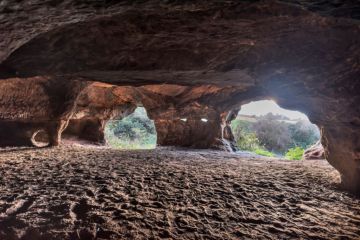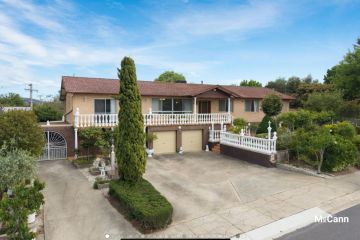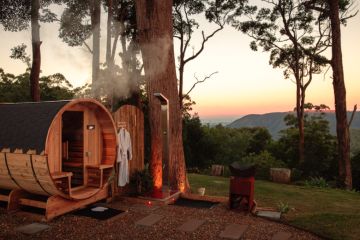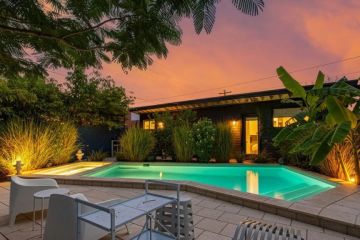The Canberra homes that combine the best of city and country
Space, scenery and serenity are a few of the attractions that lure Canberra buyers to rural properties, but some are finding homes that offer all of these benefits without crossing the ACT border.
It’s the bush capital, after all, and reserve at the back door is one of the perks of living in this picturesque corner of the world.
Greenery has been an integral part of the Canberra master plan since the days of Walter Burley Griffin.
New suburbs in Molonglo Valley and Gungahlin are nestled among bushland and carefully protected by cat containment laws.
City planning ensures most residents are within an easy stroll from green spaces and nature parks, however properties that offer direct access onto reserves are particularly sought-after, according to home.byholly agent Holly Komorowski.
“It’s the best of both worlds and it’s a lifestyle choice,” Ms Komorowski says.
“Living in a cosmopolitan city and also being surrounded by bush is what makes Canberra so unique.
“Kids can have an adventure playground as an extension of their backyard.”
Knight Frank senior town planner and urban designer Brett Roantree says reserves are critical to the city’s layout.
“The National Capital Plan places a strong emphasis on retaining the hills, ridges and buffers that separate the individual towns and bind the city of Canberra to create a unique, natural bush setting, and providing Canberra its bush capital tag,” Mr Roantree says.
“Another distinctive feature of Canberra’s design is the maintenance of the Garden City and City Beautiful values which underpin the city.
“A well-designed suburb considers the environmental and ecological values of the site as an opportunity to add value for the future community. Incorporating the natural environment into a new suburb gives it a sense of place for the new community.”
While the surrounding environment remains one of the factors that guide town planning, properties backing or adjacent to reserve are less common in Canberra’s new suburbs, with solar orientation becoming the No. 1 design consideration.
“ACT planning policies strive to mitigate the impacts of these seasonal variations, with a particular focus on the impacts of the winter months and provisions of north solar access,” Mr Roantree says.
“In response to this we have seen a trend in the design for new estates towards grid pattern development that responds to solar orientation over other design considerations such as outlook, topography and servicing.”
While fewer reserve-side properties are hitting the market, demand for bushland surrounds remains strong.
In newer suburbs, homes that are positioned near nature, golf courses and greenery have a premium attached, while streets backing or adjacent to reserve in established suburbs often attract record sales.
Duffy Street in Ainslie, Mirning Crescent in Aranda and even Canberra’s most expensive street, Mugga Way in Red Hill, are all prime examples.
Every region of Canberra has its bushland pockets – from Mulligans Flat in Gungahlin to hills and ridges of Tuggeranong.
“It’s one of the amazing things about the bush capital,” Ray White Belconnen agent Andrew Lonsdale says.
“If you have a block backing reserve you can feel like you’re on five or six acres. Families want their kids to live in Canberra, but experience a semi-rural lifestyle.”
Top reserve-side addresses
- Duffy Street, Ainslie: Duffy Street frames the western border of Mount Ainslie Nature Reserve and it’s one of the most tightly held streets in the inner north. The suburb record was smashed last year when 53 Duffy Street sold for $1.8 million.
- Mirning Crescent, Aranda: Aranda is nestled among reserve at the base of Black Mountain under the canopy of towering gumtrees. Number 50 Mirning Crescent holds the suburb record of $1,187,000.
- Mugga Way, Red Hill: One of the defining characters of Canberra’s most expensive streets is its reserve-side setting. Mugga Way frames the eastern border of Red Hill Nature Reserve and its homes command a multimillion-dollar price tag. The suburb and ACT records stands at $7.3 million for the sale of No. 27 in 2010.

Fond farewell
Annette, pictured, has called bushland-backing Mirning Crescent home for almost 50 years.
She and her husband built their first home on the tranquil Aranda street in 1969. When an architect-designed property across the street hit the market in 1986 they decided to make the move.
Embraced by reserve, their home is a peaceful sanctuary within moments from the city.
“It’s just beautiful, as you come around the bend it’s like a rainforest,” Annette says.
Annette’s grandchildren live in Oslo and they love their visits to the Australian bush where they can see kangaroos at the doorstep.
With one child in Norway and another in Melbourne, the couple have decided to move to Victoria to be closer to their son.
They are selling their property at 38 Mirning Crescent but they’re not saying goodbye to the bush. They’re building a new home under a treetop canopy in the Mornington Peninsula.
Cover property

38 Mirning Crescent, Aranda
$1.2 million-plus
5 bedrooms, 2 bathrooms, 2 car spaces
Bushland surrounds are just one of the standout features of this property in Aranda.
Designed by renowned local architect Roger Pegrum, it has won a number of awards including the ACT Chapter of the Royal Australian Institute of Architects’ C.S. Daley Medal in 1974.
Ray White Belconnen agent Andrew Lonsdale says Pegrum was the architect behind each renovation and extension over the years, which has helped achieve the home’s seamless design.
“It really is an architectural masterpiece of the ’70s and to have the same architect involved throughout every renovation is special,” Mr Lonsdale says.
The additions have been consistent with the original concept of wrapping the house around the outdoor spaces, creating garden and bushland outlooks from each room of the home.
Native gardens carry the bushland onto the property, while the use of natural materials, including ash floors and timber details, invite the tranquil surrounds into the home.
The main bathroom was renovated in 2014 and features a curved vanity, freestanding volcanic limestone bathtub, skylights and under-floor heating. It won the Master Builders of Australia’s bathroom of the year award and received a Institute of Architects’ commendation.
Nature parks bound two sides of the home, which is close to both Belconnen and the city.
Lonsdale says it is difficult to price such a rare find in Aranda, however it is expected to exceed the suburb record of $1.187 million.
Auction: Saturday, November 5, at 11.30am, onsite. Inspect: Saturday and Sunday, 11am-noon. Agent: Ray White Belconnen, Andrew Lonsdale 0428 486 692.
We recommend
States
Capital Cities
Capital Cities - Rentals
Popular Areas
Allhomes
More







